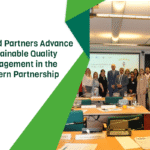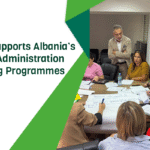In a rapidly evolving labour market, public administrations across Europe are facing a common challenge: how to remain attractive employers in the eyes of younger generations and highly skilled professionals. This was the central theme of our first Member States Roundtable titled “Attracting Tomorrow’s Talent: Public Administration as an Employer of Choice.”
The roundtable brought together senior representatives from the European Commission, Spain’s National Institute of Public Administration (INAP), Bulgaria’s Institute of Public Administration, and the OECD, offering a rich and multi-perspective dialogue on modernisation, talent retention, and the future of public employment.
The European Commission: A Four-Pillar Strategy for Relevance
Marta Silva Mendes, Head of Unit at the European Commission’s Directorate-General for Human Resources and Security, opened the discussion by outlining the Commission’s human resources strategy. While the Commission continues to attract thousands of applicants and maintains high staff engagement, it recognises the need to evolve.
The strategy is built on four pillars:
- Attractiveness: emphasising flexibility, well-being, and meaningful work
- Faster recruitment: reducing long hiring timelines to meet the expectations of younger candidates
- Career development: promoting internal mobility and growth opportunities
- Innovation & simplification: streamlining processes and embracing change
Silva Mendes also highlighted a large-scale internal review underway, aimed at benchmarking the Commission’s practices and delivering actionable recommendations by 2026 to ensure the Commission remains agile and efficient.
Spain: Building Consensus for an Open Administration
Manuel Pastor Sainz Pardo, Director General at INAP, presented Spain’s “Consensus for an Open Administration” strategy, a participatory roadmap developed through multi-stakeholder consultation. The strategy is structured around four axes, with the first focusing on investment in public sector capacity.
Key components include:
- Technology: developing AI platforms and data lakes to support policy design
- People: rethinking recruitment, enhancing career paths, and defining a clear employer value proposition
Pastor Sainz Pardo emphasised the need to modernise Spain’s traditional recruitment system, which favours memorisation and lengthy preparation, and to align it with the learning styles and expectations of younger generations.
Bulgaria: Measuring Engagement and Readiness
Pavel Ivanov, Executive Director of Bulgaria’s Institute of Public Administration, shared findings from the country’s Engagement Barometer and AI Readiness Index. These tools help institutions assess internal motivation, leadership trust, and preparedness for digital transformation.
Key insights included:
- Declining engagement poses risks to reform and innovation
- Transparency and data-sharing empower institutions to self-assess and improve
- AI adoption requires not just tools, but cultural and organisational readiness
OECD: A Multi-Generational Approach
Daniel Gerson, Head of Public Employment at the OECD, stressed the importance of designing human resources policies that address the needs of all age groups. He introduced a framework based on three drivers of employer attractiveness:
- Career: opportunities for growth and development
- Job: meaningful work and autonomy
- Life: flexibility and work-life balance
Gerson also highlighted the role of learning and development as the strongest predictor of employee engagement, and called for better data collection to inform policy decisions.
Key Takeaways
Across the board, speakers agreed on several priorities for modernising public employment:
- Purpose-driven work is essential to attract younger generations
- Flexible career paths and internal mobility foster long-term engagement
- Faster, more transparent recruitment processes are critical
- Investment in digital tools and skills must be matched by cultural change
- Benchmarking and collaboration across institutions help drive continuous improvement
The roundtable underscored a shared commitment to making public administration not only more efficient, but also more human-centered, innovative, and future-ready.


